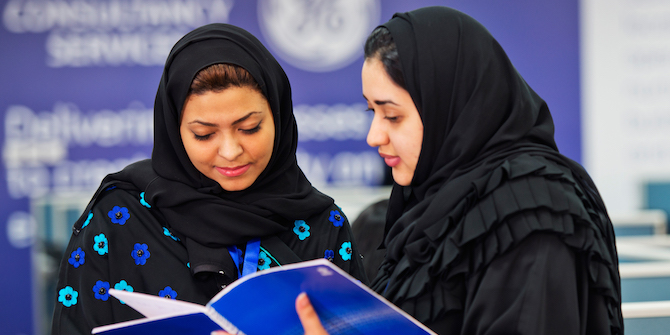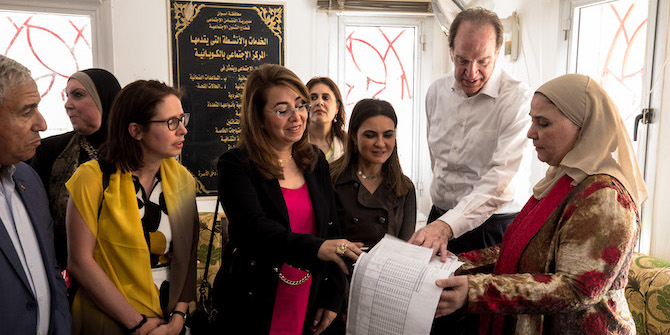By Alessandra Costagliola

A shopping mall in Riyadh, Saudi Arabia. Source: cmonville, Flickr
Large shopping malls have become an attraction for both locals and tourists across the Arab world. Shopping malls in the Arab region have become more than just places for spending, however, and have been designed to include restaurants, banks, multiplex cinemas, play areas and recreational facilities. In the Arab world, shopping malls have also come to represent locations for leisure where women can socialise and shop freely in gender segregated spaces.
The Collective Dream
Existing research on shopping malls regards these spaces as a place of empowerment for women, noting that the existence of this space allows women to ‘escape the confines of patriarchal domesticity’. Van Eeden (2006) notes further that consumerism, rather than a means of enslaving women to material goods in a capitalist society, represents shopping as an agency of empowerment and self-actualisation. Pusca (2009) describes the mall as a ‘collective dream’, highlighting that it connects the idea of happiness with the act of material consumption for both individual and collective happiness. Hastreieter and Marchetti (2016) note that women have a stronger relationship with shopping malls versus men and that the shopping mall represents a space for comfort, convenience, peace of mind and safety for them. Given the experience that shopping malls represent, particularly for women, it is no wonder that the Arab Gulf region has prioritised the shopping mall experience for its population and tourists. The sweltering heat of the Gulf disables outdoor activity making the shopping malls not only a space for engaging in consumerism, but also a space to engage in other social activities.
Indeed, the growth of shopping malls throughout the Arab world is significant. The United Arab Emirates (UAE) is most famous for its sprawling malls that attract thousands of tourists every year. The Dubai mall, one of the largest malls in the world, is 12 million square feet, containing over 1,300 shops and welcomes over 80 million visitors annually. In Saudi Arabia, shopping malls can be traced back to the 1970s, beginning with supermarkets. Initially, these supermarkets were reserved for wealthy expatriates, but by the 1980s as the economic recession hit, native Saudis were encouraged to do their shopping inside the country. By the early 2000s, more and more malls throughout the city centres began opening as lifestyles and shopping behaviours evolved. The opening of malls in Saudi Arabia was particularly necessary given that outdoor activity is limited by dry conditions and high temperatures. As a result, shopping malls in the region have become more than just a venue for consumerism, but rather, to engage in a plethora of leisure activities.
Segregated Spaces in Shopping Malls
Gender segregation in shopping malls in not unique to the Arab-Muslim world. As Van Eeden (2006) notes, in the West, American department stores after 1890 featured separate street and elevator entrances for men and women and used decorations to distinguish between male and female spaces. These measures have had implications on the modern construction of Western shopping malls which are primarily geared towards the female consumer, including bright lighting to increase women’s perception of safety and packaging and store merchandising that appeals to women shoppers.
In Saudi Arabia, gender segregation in malls allows women to engage in a multitude of social and consumerist activity in the comfort of other women. Given the high temperatures of the Gulf region, many socialising activities cannot take place outdoors, so shopping malls provide an opportunity for women to meet and converse. In Riyadh, the Kingdom Centre features an entire floor dedicated to women’s shopping activities called the ‘Ladies Kingdom’. The opening of this floor was intended to ‘capitalise on the purchasing power of Saudi women’, but as Le Renard (2014) notes, this floor also represents a space where women can engage in the ‘consumerist model of femininity’.
The activity of shopping, within the consumer space of the shopping mall, not only allows women to engage in the economy via their purchases, but it also, as Almahmood et al. (2017) note, justifies their presence in the public space. As a space outside of their homes deemed socially acceptable for women to gather, malls become ‘urban shelters’ for women. Large layouts and open areas of visibility not only provide a perception of safety for women but, according to Le Renard (2014) also enable them to feel as though these are spaces of ‘freedom’. In L’Oreal stores, for instance, the company built a sales force entirely composed of women that cater to clients ‘in an atmosphere where women can shed the abaya or act freely’. As Van Geel (2012) notes, although gender segregation is often viewed as a consequence of conservatism in Saudi society, many women argue that women-only spaces allow women to participate in Saudi public life. Indeed, some women even argue that segregated spaces are their preferred way of interaction as it makes them feel more relaxed while shopping. According to Le Renard (2014), women also use the mall as a space for socialising with other women, especially when access to friends’ homes is limited by tradition or conservatism, given the chance that women may harm their reputation if they are visible to their friends’ male relatives in the household. Because opportunities for socialising with other women are so limited, malls provide a shared space among women to strengthen social ties. The social implications of the mall environment have largely limited the success of ecommerce in the Gulf region, viewed by most Saudi women as not being an alternative to traditional shopping.
The Future of Segregated Spaces
Over the last few years, Saudi Arabia has moved to create more shared spaces for men and women. Although the disintegration of segregated public spaces for women in Saudi demonstrates a shift towards gender equality, for women, this may also prove challenging due to the benefits that these segregated spaces provide. As segregated spaces gradually become obsolete in the country, women may not only feel they are under constant surveillance, but they may also lose out on the opportunities for social engagement, relaxation and freedom that segregated spaces provide in a highly patriarchal and conservative society.







thank you very much for sharing this article, I enjoyed reading it and makes me realize that you can find peace alone inside a mall because of its different spaces for people
Quality posts are important to invite the visitors to visit the website, that’s what this website is providing.